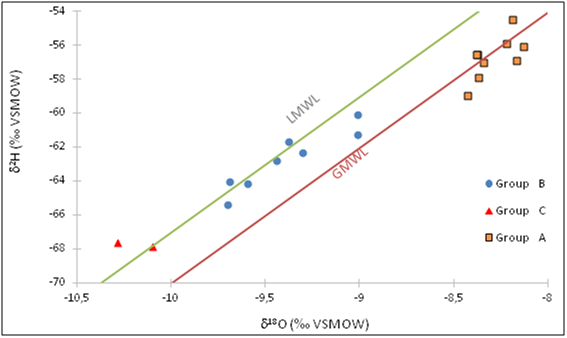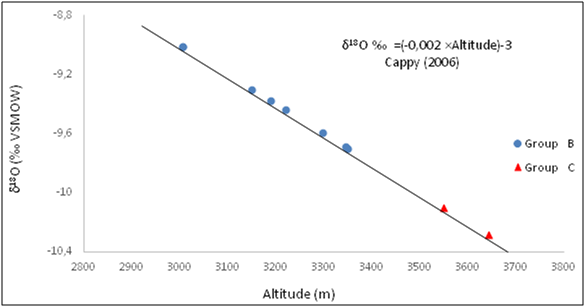International Journal of
eISSN: 2576-4454


Research Article Volume 2 Issue 3
1Department of Earth Science, Cadi Ayyad University, Morocco
2Department of Industrial Engineering, Ibn Zohr University, National School of Applied Science, Morocco
3Department of Earth Science, Cadi Ayyad University, Morocco
4Laboratory of Data Processing, Recognition of Seismic Waves and Structure of the Earth, Morocco
5Department of Toubkal National Park, Regional Direction of Water and Forest and Fight against Desertification High Atlas, Morocco
6Laboratory of Applied Geology and Geo-Environment, Ibn Zohr University, Morocco
Correspondence: Kacem Lamyaa, Department of Earth Science, Cadi Ayyad University, Morocco
Received: May 01, 2018 | Published: May 10, 2018
Citation: Lamyaa K, Mbark A, Brahim I, et al. Isotopic characteristics and water interaction of Ifni Lake and spring of Tifnoute valley (high Atlas Mountains, Morocco, North of Africa). Int J Hydro. 2018;2(3):306-310. DOI: 10.15406/ijh.2018.02.00087
Geochemical and isotopic investigations were carried out to indicate the interaction process between Ifni lake water and high valley of Tifnoute springs. A total of 18 water samples were collected and analyzed. The Ifni lake constitutes a veritable water resource in the study area, and this water can be the origin of alimentation the springs located in the high valley the Tifnoute. This study aims to improve the interaction between Ifni lake water and the springs of high valley of Tifnoute. It is mainly focused to identify the origin of groundwater recharge and mineralization. The environmental isotope (deuterium (δ2H) and oxegen-18 (δ18O)) measurements allowed understanding the hydro geochemical process, the origin of the mineralization of the water. Also the results identify the relationship between the waters of Ifni Lake and the spring's water of high valley of Tifnoute. The isotopic compositions reveal that the origin of Ifni lake water is meteoric, and the water infiltrates directly in the groundwater without any evaporation.
Keywords: Mountain water, isotopic process, hydrogen and oxygen isotopes, lake-groundwater interaction
Morocco is one of the countries that must cope with an important water deficit.1 Also, these regions are particularly sensitive to variability induced from climate changes.2‒5 Groundwater and surface water constitute a single complex and interconnected system.6,7 In many mountainous rural areas in Morocco the spring’s water represents a source of dirking water. In the high valley of Tifnoute, the spring’s water is used for human consumption. Generally, water in these mountain area characterized by low mineralization. Also this area characterized by the highest mountain, and natural lake in Morocco. Water from Ifni Lake outflows by springs which are located just downstream from the lake. The people in the high valley of Tifnoute used spring water for drinking and irrigation.8 The water isotopes (18O,2H) are excellent tracers for determining the origin of groundwater; they are widely used in studying the natural water circulation and groundwater movement, also due to their conservative characteristics of moving with H2O molecule.9,10 Using of isotopic tracers is an effective approach for investigating the complex hydrological processes of groundwater range of spatial and temporal scales.11‒17 Also spring, precipitation and surface water respond to the isotope signature of atmospheric water.18‒20 The changes in stable isotopes overtime and in space can provide a better understanding of aquifer recharge and discharge.21‒23 In the study area the Ifni lake constitutes a natural tower of water witch aliments a majority of springs, this area has never been the subject of isotopic study. The aim of this work is to improve the ground-surface water interaction, using isotopic process. Moreover, stable isotope (δ2H,δ18O) and chemical analyses reveal a clear relation between Ifni Lake and some springs water. The isotopic analysis of the waters allowed us to understand the hydro geochemical process, the origin of the mineralization of the water and also to identify the relationship between the waters of Ifni Lake and the spring's water of high Tifnoute Valley.
Study area
The high valley of Tifnoute is located in the Moroccan High Atlas between latitudes 30°59′ and 31°5’ North, and longitudes 7°56′ and 7°48′ West (Figure 1), one of the interesting area in the National Park of Toubkal. The area characterized by semi-arid climate with important precipitations, and dendritic hydrographic network (Figure 1). The high valley of Tifnoute catchment it’s characterized by highest elevations, a greater degree of slopes,24 and irregular terrain.25 Geologically, the study area is dominated by volcanic and metamorphic rocks essentially are: andesite, basalt, granite and rhyolite. In the Tifnoute Valley, part of the ancient massif, three units of plutonic rocks have been defined.26 The Askaoun intrusion showing quartz diorites and granodiorites, intrusion of Imourkhssen, formed of coarse-grained granite, and Ougougane intrusions made of fine-grained granite.
Observations and hypotheses
We find the very important water resources in the high valley of Tifnoute, springs and surface waters. Ifni Lake is the natural dam of water in this area, which alimented the important springs. Mainly, some springs waters located under lake level had similar chemistry composition of Ifni lake water. The relationship between Ifni lake and springs water is very special: the waters of a ‘’small watershed’’ coming from the melting of snow and accumulate in the lake, then during all the year this water is transit by natural underground conduit whose exit it at the nearer springs (Tinkhar N’ifni and Tamda). Tamda is the name given by the population in this region to a small topographical water depression (Figure 2) situated at 2192m of altitude in the south East of the lake. When water reaches a level at Ifni lake (Reference rock situated at an altitude of 2320m), the water gushes a week after in the Tamda spring (Figure 3). So, this suggestion can explain the relationship between Ifni Lake and Tamda spring water and we used isotopic analyses to verify this observation.
Water sampling and analysis
A total of 18 water samples were collected from high valley of Tifnoute springs, and Ifni Lake during the period of May 2015. The spring’s location was determined using a global positioning system (GPS) (Figure 1). Eventually, samples were collected in glass bottles for stable isotopes analysis. The samples were preserved and transported in laboratory. Stable isotope of waters deuterium and oxygen-18 compositions were analyzed using cavity ring down spectrometry (Picarro L2120) at Laboratory of Applied Geology and Geo-Environment, Ibn Zohr University. The values are expressed in Standard Mean Ocean Water (SMOW) in per mill %.
Generally, the spring waters in this mountain area are characterized by low mineralization.8 The Ifni lake is located at 2320m in this mountain area, mainly this lake and spring waters fed by atmospheric precipitation and snow. Ifni lake water characterized by 80µs/cm of conductivity, and 8.4 of pH. The water composition is rich in magnesium, calcium and bicarbonate ions. Isotopic data (Table 1) reveal the δ18O values of samples range from -8.13 (S5) to -10.28 (S22) vs‰ V-SMOW, whereas the δ2H values range from -55.89 (S6) to -67.83 (S8) vs‰ V-SMOW. The water sample collected from Ifni lake presents this isotopic content: δ18O=-8, 43 and δ2H=-59 ‰ (Table 1). The diagram (Figure 4) show the water samples plot compared to the global meteoric water line (GMWL),27 and local meteoric water line (LMWL).28 Usually, deviations in isotopic compositions away from meteoric water line may results from processes of evaporation.29‒31 The results (Figure 4) show that the most of water samples plot on (GMWL) and have isotopic signatures close to those of meteoric water, which explains that the origin of waters is meteoric and it was infiltrate directly. We can subdivide the water samples into three groups according to their isotopic signatures:

Figure 4 δ2H versus δ18O diagram of water as compared to the global meteoric water line (GMWL) and the local meteoric water line (LMWL).
Water samples |
δ18O SMOW |
δ 2H SMOW |
Altitude (m) |
Ifni Lake |
-8,42475 |
-58,97725 |
2327 |
S1 |
-8,34175 |
-57,04875 |
2177 |
S5 |
-8,13075 |
-56,076 |
2059 |
S6 |
-8,22025 |
-55,8925 |
1962 |
S7 |
-8,371 |
-56,532 |
1895 |
S8 |
-10,099 |
-67,838 |
2202 |
S9 |
-9,3 |
-62,3355 |
2143 |
S12 |
-9,00875 |
-60,1065 |
2267 |
S13 |
-8,19 |
-54,50425 |
2076 |
S15 |
-9,011 |
-61,295 |
1775 |
S17 |
-9,37625 |
-61,70825 |
2073 |
S18 |
-8,37675 |
-56,5475 |
1885 |
O1 |
-8,3675 |
-57,93525 |
1716 |
O2 |
-9,6985 |
-65,373 |
1774 |
S19 (Tamda spring) |
-8,1685 |
-56,91725 |
2183 |
O3 |
-9,4385 |
-62,7845 |
1717 |
S22 |
-10,28325 |
-67,6355 |
2142 |
S23 |
-9,59475 |
-64,12825 |
1872 |
Table 1 Isotopic contents of water samples in the high valley of Tifnoute
To identify the altitudes of the recharge conditions of these waters, we used the altitudinal gradient established by Cappy32 using the equation 1.33,34
(1)
The results (Figure 5) show that the waters originate from the high altitudes areas between 3000-3600 m, come from the high Moroccan Atlas. Therefore, the springs would be recharged by the fissure water and precipitation.

Figure 5 Relationship between δ18O in the water samples and their recharge elevation according with altitude gradient of Cappy.32
The high valley of Tifnoute is a mountainous study area characterized by very important softly water resources, the Ifni Lake is a natural dam situated at 2320m, and aliments the springs water in this region. To indicate that the origin of this water is the lake we organized the different companies to collect the maximum of information from population. Also, to prove the interaction lake-springs the isotopic investigations were defined. The results showed that high precipitation water and the snow melt are the origin of Ifni Lake. The δ18O and δ2H data in springs water indicating that the water origin is meteoric, and a local recharge of the study area waters from areas at 3600 m altitudes, which correspond to the High Atlas Mountains (Jbel Toubkal).
None.
The authors declare there is no conflict of interest.

©2018 Lamyaa, et al. This is an open access article distributed under the terms of the, which permits unrestricted use, distribution, and build upon your work non-commercially.